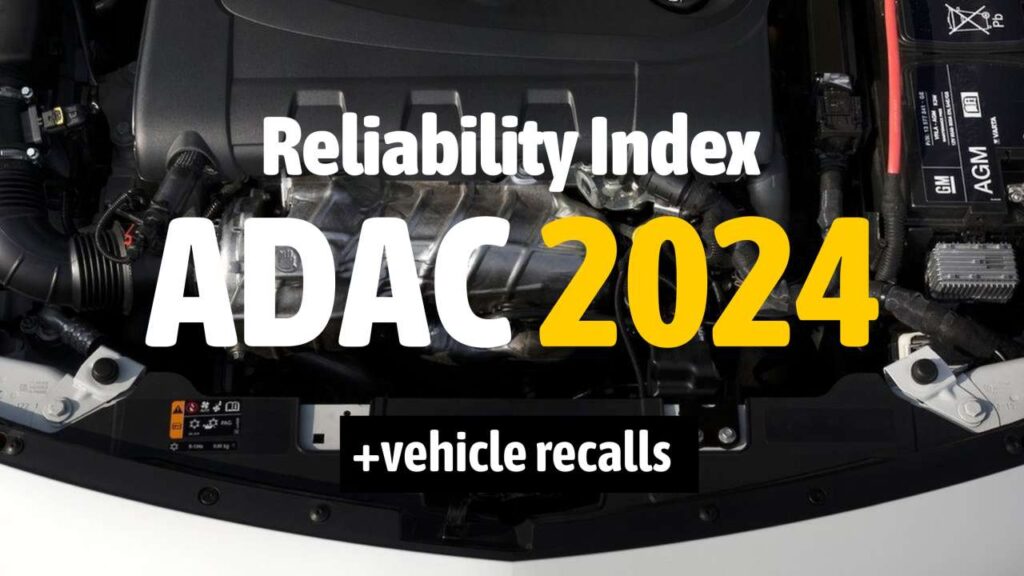The German Automobile Club ADAC Reliability Index for 2024 rates 156 models of 20 car manufacturers between three and ten years old, of which at least 7,000 have been registered in Germany in some period between 2014 and 2021. The ADAC Reliability Index is calculated from the number of Yellow Angel roadside assistances per 1,000 registered vehicles.
The most common cause of failure was again the starter battery (44.1% of all assists). Engine and control system faults were second (22.8%), and problems with alternators, electrical systems, and lighting (10.5%) came in third. Other common reasons for requesting assistance included tyres (8.8%) and locking systems (7.1%). The statistics do not include assistance for self-inflicted problems, such as running out of fuel or not having a spare wheel.
The total number of ADAC Yellow Angel road assists in 2023 was 117,570 higher than in the previous year. The average age of the vehicles that broke down was 12.9 years.
In this year’s breakdown statistics, electric cars proved to be more reliable than cars with internal combustion engines. Electric vehicles newly registered in 2021 had an average of only 2.8 defects per 1,000 vehicles, compared to 6.4 for internal combustion engine vehicles.
The least reliable cars
In our table of the 22 least reliable cars, we picked vehicles from all the evaluated categories with a high probability of a road defect in at least one year (marked in red in the table). You can find all the cars by segment in the tables under the following links:
- City car / Mini-compact
- Supermini / Subcompact
- Small family / Compact
- Large family / Mid-size
- Executive / Full-size
- Vans
To stay consistent with the primary focus of our site, when you click on each model, you will see their recalls.
Most defects alphabetically
| Model | 2021 | 2020 | 2019 | 2018 | 2017 | 2016 | 2015 | 2014 |
|---|---|---|---|---|---|---|---|---|
| Fiat Ducato | 21,4 | 31,5 | 30,1 | 22,2 | 28,0 | 31,0 | 39,4 | 49,2 |
| Ford Focus | 4,2 | 7,6 | 10,8 | 13,7 | 13,4 | 20,7 | 24,9 | 31,0 |
| Ford Kuga | 25,4 | 24,1 | 12,5 | 15,2 | 16,8 | 19,3 | 25,3 | 23,9 |
| Ford S-Max | — | — | — | 31,9 | 35,2 | 48,2 | — | 15,8 |
| Ford Transit | 6,9 | 9,9 | 20,1 | 7,0 | 12,2 | 24,4 | 22,7 | 31,3 |
| Hyundai i10 | 5,3 | 11,3 | 14,9 | 25,4 | 25,1 | 22,7 | 20,9 | 19,1 |
| Hyundai i20 | 13,8 | 6,1 | 5,0 | 11,3 | 15,1 | 15,7 | 22,4 | 29,9 |
| Mazda 3 | — | 12,4 | 24,9 | 5,0 | 7,6 | 14,3 | 14,2 | 13,1 |
| Mercedes Citan | — | 23,2 | 15,6 | 22,0 | 20,6 | 24,0 | 26,3 | — |
| Nissan Qashqai | 4,5 | 13,1 | 23,0 | 17,4 | 13,7 | 16,0 | 20,4 | 21,5 |
| Opel Insignia | 14,2 | 14,3 | 21,4 | 26,5 | 31,3 | 41,3 | 36,1 | 28,6 |
| Opel Meriva | — | — | — | — | 30,3 | 31,0 | 23,3 | 24,0 |
| Renault Clio | 6,0 | 15,0 | 16,3 | 19,2 | 24,4 | 32,0 | 39,4 | 34,0 |
| Renault Kadjar | — | 4,0 | 8,5 | 9,2 | 16,4 | 27,5 | 29,5 | — |
| Renault Master | 16,7 | 25,3 | 33,0 | 8,0 | 10,6 | 14,7 | 17,0 | — |
| Renault Megane | 5,0 | 8,3 | 9,3 | 16,7 | 22,9 | 34,0 | 29,0 | 23,7 |
| Renault Scenic | — | — | 25,1 | 26,2 | 21,9 | — | 23,1 | 21,6 |
| Smart Forfour | 2,2 | — | 14,3 | 26,0 | 30,3 | 28,6 | 25,2 | — |
| Toyota C-HR | 22,0 | 51,5 | 47,5 | 38,2 | 31,7 | — | — | — |
| Toyota RAV4 | 17,6 | 26,9 | 30,8 | 23,2 | 29,5 | 27,6 | — | — |
| Toyota Yaris | 27,8 | 16,8 | 6,7 | 10,0 | 14,4 | 22,3 | 22,2 | 25,6 |
| VW Sharan | — | — | 8,7 | 11,7 | 14,8 | 24,5 | 30,4 | 26,7 |
The evaluation of the frequency of failures follows a colour scheme from dark green (very low) to red (very high). Cars with many model years in the green rating are less likely to be a source of problems, while cars with few model years in the red rating should be selected with caution. However, the Reliability Index should only be seen as a guide. The quality of a vehicle can vary from the statistical rating – both in a positive and negative sense.
